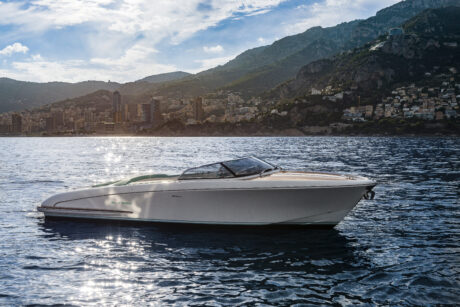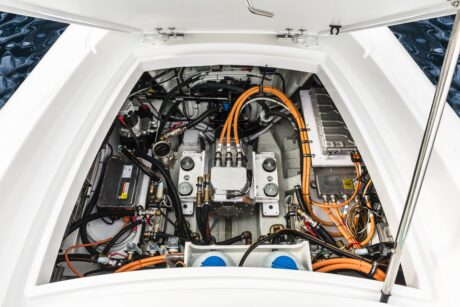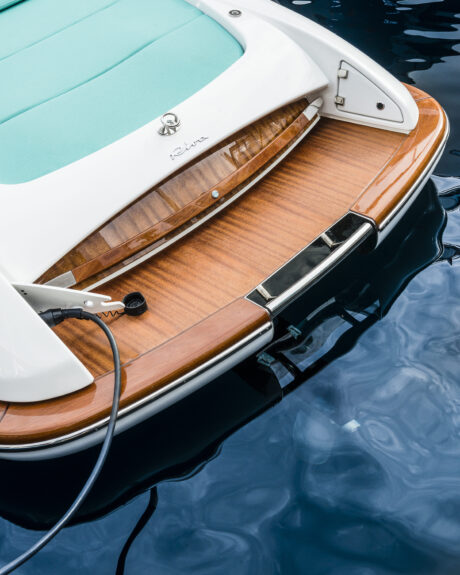Sustainability is driving the adoption of electric solutions in almost every industry, including boating. The aim is to reduce our carbon footprint and minimise emissions that damage the environment. Boating is a particularly challenging sector for electrification because it requires high performance motors and long runtimes.
The future of electric boating
Ferretti Group is among the world leaders in the design and construction of pleasure boats, offering highly successful models like the iconic Riva Iseo, loved everywhere for its exceptional quality and exclusive design. This is the model that became the base for a new electric prototype known as the Riva El-Iseo, which was recently launched in Monaco.

Parker Hannifin, a global motion and control technology company, supplied its GVM310 high-performance electric motor, which meets the following requirements:
- a power output of 250 kW and 300 kW peak;
- a cruising speed of 25 knots and a self-limiting top speed of 40 knots;
- up to ten hours of navigation in economy mode.
The challenges to making electric boats
All fully electric mobility solutions face the constraint of battery capacity. Li-ion battery cells have a significant footprint, and the higher the power demand, the larger the battery requirement. Electric boats are no different, but the available space is even more limited. Batteries also add weight to the boat, adding to the power requirement.
In high-performance boating applications, the motor must drive the propeller at high speeds while still providing maximum power and torque. These simultaneous requirements are challenging for electric solutions. The motor must run at high instantaneous current and current density, resulting in an operating envelope close to its thermal limits.
Runtime is also a critical factor for boating applications. Owners expect to be out on the water for a full day without needing to charge the battery. This requirement means that the motor should perform acceptably across the entire normal voltage range of a battery, from fully charged to almost completely depleted. If performance deteriorates at lower voltages, the user experience will be less satisfactory, discouraging the adoption of electric solutions.
Key elements of Riva El-Iseo
The Riva El-Iseo is a high-performance power boat that needs maximum power and torque at high propeller speeds. This requires high current and current density from the electric motor, pushing the system close to its thermal limits. For this reason, Parker conducted extensive simulation and characterisation tests using proprietary tools to identify and select a motor that could meet the requirements.
After initial characterisation and simulation tests, the team adjusted the design requirements of speed, torque, and power. Understanding the thermal behaviour of the motor was critical to the design because of the requirement for high performance. This made the use of thermal characterisation tools essential. Only through an iterative process using Parker’s proprietary tools was the team able to verify their design and select the ideal components.
The electric technology behind the Riva prototype
The Riva El-Iseo uses an electric motor designed for the mobile market by Parker. The GVM310 has the ideal characteristics for the boating environment, boasting 97% efficiency and a very high power density. Both these characteristics are vital for the boating environment, where long runtimes are required from compact motors that do not occupy a large footprint on the boat. The patented cooling system reduces motor noise and improves efficiency and performance.

GVM motors perform consistently across a wide voltage range from 24 to 800 VDC, for boating from when the battery is fully charged to almost completely depleted. These very light, low-inertia motors offer designers the combination of peak power at high speed essential for boating applications. The maximum speed of the GVM310 is 8,000 rpm.
GVM range motors from Parker are robust and able to endure the challenging conditions of boating needs. They resist salt water, have a high vibration threshold, and can handle sudden shocks to the system. GVM motors can operate in ambient temperatures as low as -40°C and as high as 140°C.
A GVI inverter converts the DC battery power to AC power for the motor. This technology is designed for mobile applications with a wide voltage range and the capability to supply the peak power demand of the GVM310. The inverter is also water-cooled, which improves its efficiency and reduces its footprint on the boat. GVI products offer a high degree of protection from water and dust ingress.

GVM motors contain thermal sensors for protection against overheating. They activate an alarm via the control panel in the case of high temperature and can be configured to make automatic adjustments to the supply current from the inverter. A cut-off sensor protects the motor from damage if safe operating limits are exceeded.
The mechanical connection
Although the mechanical connection between the motor and the propeller fell outside Parker’s scope in this project, this coupling is a critical contributor to system reliability. Excessive vibration from the propeller on the motor shaft can cause long-term damage or even catastrophic failure. For this reason, Parker helped the customer with advice about the coupling design best suited to the application. The optimum coupling design includes specifications for springs as well as the location and type of supports. Parker’s input to the design ensured efficient power transfer to the propeller without generating vibrations on the motor.
Conclusion
Riva El-Iseo offers exceptional speed, power, and torque performance based on the GVM310 motor and GVI inverter from Parker. The solution implemented by Parker delivers a power output of 250 kW and 300 kW peak, with a cruising speed of 25 knots and a self-limiting top speed of 40 knots.
The thermal load challenges created by the demand for high performance have been overcome. Built-in thermal sensors alert users when the motor temperature exceeds normal operating limits. The design of the mechanical coupling also ensures that vibrations from the propeller do not impact motor reliability.
This prototype achieves excellent performance without limiting the runtime beyond user expectations. The robustness of the GVM310 solutions allows for up to ten hours of runtime in economy mode.



